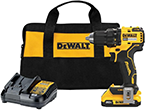Hanging Pictures on Concrete Walls
Written by Lee Wyatt (last updated November 23, 2018)
If you have even one concrete wall in your home, then you know how difficult it can be to hang pictures on it. Traditionally, hanging pictures on these types of walls would require that you drill some holes into the wall. While it may work, in the long run this is a fairly intrusive and potentially destructive method to increase the beauty of your home. That being said, there is another method you can use to get the job done that isn't as intrusive.
Items needed:
- Hard-wall picture hanging kit
- Tape measure
- Scale
- Hammer
- Straight edge
- Level
- Pencil
Procedure:
- Measure and weigh. Before you go out and purchase the hard-wall picture hanging kits that you will use to hang your artwork, you need to do a little weighing and measuring. Pull out a tape measure and your scale. Use the tape measure to get the dimensions of your artwork, and the scale to get how much the artwork weights. Ideally you will get the length, width, and the diagonal length as well (in the same manner that you would with a television set. Use this information to get the proper size kit for your artwork.
- Place markers. Use a pencil and place a mark where you intend to hang the pictures. You may want to use a straightedge to ensure that the marks are at the least in a straight line. Do this for as many pictures as you plan on hanging. You want to use a pencil so that you can erase the marks as necessary until you have everything where you want it to be.
- Level it all out. Double-check to make sure that your marks are all leveled out as much as possible. If necessary, you may need to erase the marks a few times to ensure that they are actually leveled.
- Mount the hooks. Press the flat part of one of the plastic hangers against the first marker that you made. When you do this, make sure that the hook is towards the floor, and the three metal prongs on it are pointed towards the ceiling. Once you have done that take a hammer and hit the metal prongs at the top of the hanger until they are flush with the rest of the hanger.
- Hang your picture. If the picture you are hanging isn't particularly heavy, you can now hang the picture. In the event that you are hanging a larger picture, you may want to repeat the process described in step 4 to help distribute the weight more evenly. Once you have hung the picture, use the level to ensure that your picture is not crooked.
- Repeat as necessary. Repeat steps 2 through 5 as many times as necessary until you have hung all the pictures you will be hanging.
- Double-check the level. After you have hung all your pictures, take the time to go through and double-check that they are completely level again. The best way to do this is by using a level, and placing it on top of the frame.
Author Bio
Lee Wyatt
Contributor of numerous Tips.Net articles, Lee Wyatt is quickly becoming a regular "Jack of all trades." He is currently an independent contractor specializing in writing and editing. Contact him today for all of your writing and editing needs! Click here to contact. Learn more about Lee...
How to Detail Your Car
Why pay someone else to detail your car when you can do it yourself? Save some money, and make your vehicle beautiful at ...
Discover More
Understanding Upholstery Cleaning Codes
Getting your upholstery clean can often be little difficult for those who have never done it before. One of the best ...
Discover More
Installing Auxiliary Gas Heaters
No one really likes the excessive cold of the winter months, at least they don't like living in it all the time. One way ...
Discover More
More Home Improvement Tips
Understanding Wallboard Finishing Levels
If you are thinking of having any type of wall work done in your home, then it is a good idea to understand the basics. ...
Discover More
Hanging Pictures Easily
Pictures have a way of brightening up a room and making a house a home. By learning a few basic techniques, you will be ...
Discover More
Recognizing a Load-Bearing Wall
Recognizing a load-bearing wall isn't all that difficult, though it can save you a huge amount of money, and time. All ...
Discover More

Comments